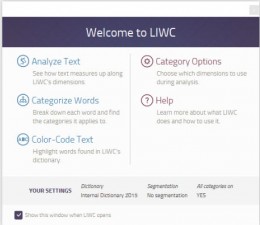 “Using LIWC for Computational Linguistic Analysis” will be presented from 1:30-3:30 p.m., Friday, Mar. 4, via Zoom. (Link will not be live until the event.)
“Using LIWC for Computational Linguistic Analysis” will be presented from 1:30-3:30 p.m., Friday, Mar. 4, via Zoom. (Link will not be live until the event.)
The Linguistic Inquiry and Word Count (LIWC, pronounced “luke”) tool enables users to conduct computational linguistic analyses on single texts, collections of texts, and text corpora, in order to better understand the latent data.
This presentation will include an overview of the linguistic analysis sequence: research design, curation of text sets, data cleaning, exploration of texts and data analytics using LIWC, and common methods for reporting the research information.
Some LIWC capabilities
LIWC enables the classic counts of word and punctuation types, often used as proxies for text complexity and structural composition. There are function word counts used for author stylometry.
There are:
- Descriptive composite scores (reported out as percentiles) based on years of text research: analytic, clout, authentic, and tone (sentiment, emotion).
- Psychological constructs (of authors) based on affect, social, perceptual processes, and drives. These linguistic elements are built off of psychological models and psychological research.
- Human-based constructs: biological processes, time orientation, relativity, personal concerns, informal language, and cognitive processes.
In all, there are over 90 output variables.
LIWC enables the incorporation of outside dictionaries (in various languages) and even custom researcher-created dictionaries for different analytical applications. (The built-in dictionary, though, is not editable by users).
A brief history
LIWC originated in the early-to-mid 1990s to study the potential effect of writing on human health. Through the years, it has evolved (LIWC2001, LIWC2007, and now LIWC2015). In its current version, it is comprised of a processor and a built-in dictionary.
As a research instrument, it is well documented and solidly tested, with documented confidence levels for particular metrics (The Development and Psychometric Properties of LIWC2015 by J.W. Pennebaker, R.L. Boyd, K. Jordan, and K. Blackburn). The newest manual is available here, for LIWC-22.
LIWC has been used in a variety of ways and garnered wide usage. It is mentioned in numerous academic periodicals and books. Dr. James W. Pennebaker, one of the principals behind this tool, gave a TEDx (Austin) Talk titled “The Secret Life of Pronouns,” which is based on his book of the same title.
While LIWC is well documented (to the point of near-transparency), it is a closed source tool (so no access to the code directly). In the research literature, this tool has been applied in creative ways, including remote author profiling, genre analysis, suicidality analysis, social status analysis, predictive analytics, and other applications.
Custom dictionary
If time allows, there may be a light introduction about how to create a custom dictionary for use with LIWC for unique applied research. There are free downloads of others’ custom dictionaries for various research applications, too.
Software cost
The software tool itself is available through subscription through Pennebaker Conglomerates, Inc. Currently, K-State does not have a site license for this software. This tool is not required per se to participate in the session.
Contact
No RSVP is needed for this event. K-State staff may enroll for this training through HRIS. Registration is not required. If there are any questions, please contact shalin@k-state.edu or call 785-532-5262.